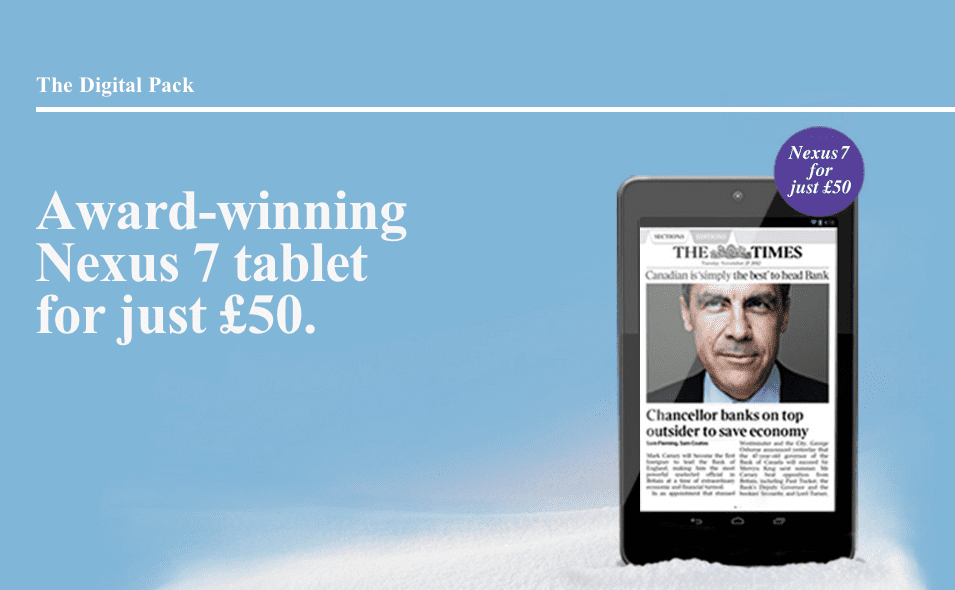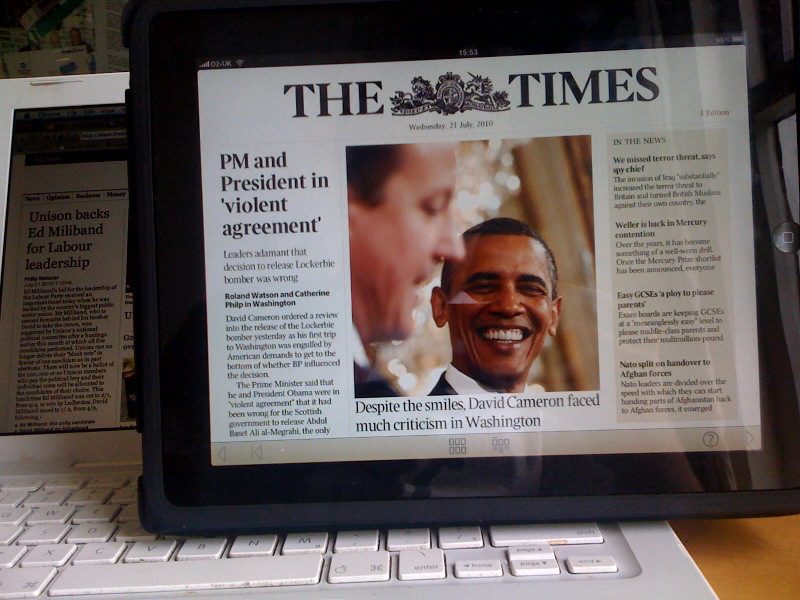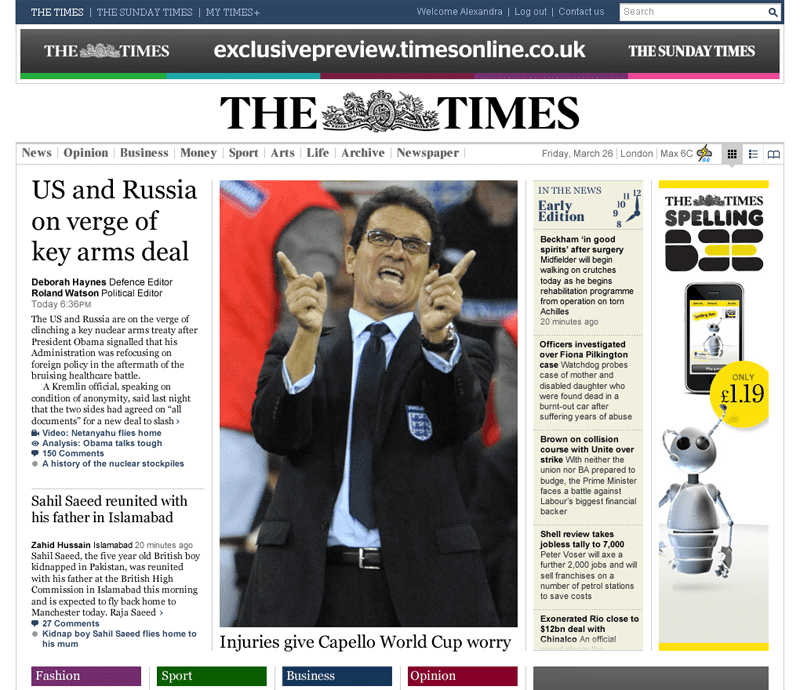
When I reported this week that News Corp’s The Times was selling a Nexus 7 tablet for just £50 with its digital newspaper subscriptions, it attracted much interest. It is one of the first major papers to leverage content and tablets in a bundle.
So I caught up with News International customer sales director Chris Duncan to find out more about the deals he is using to acquire new paying customers…
iPad bundling couldn’t work
 When iPad — and, with it, several digital newspaper editions — launched in 2010, many observers expected the two to be offered together, just as pay TV firms and mobile networks subsidise set top boxes and handsets with contracts.
When iPad — and, with it, several digital newspaper editions — launched in 2010, many observers expected the two to be offered together, just as pay TV firms and mobile networks subsidise set top boxes and handsets with contracts.
“We had looked at it for a while — originally with the iPad,” Duncan says. “But the economics of it were difficult. We were £2-a-week and the iPad was up in the £500 mark and the economics just didn’t work very well.”
Instead, now that rival tablet devices (and sizes) are falling, News International has teamed up with Nexus maker Asus (and not Google) to knock 75 percent of the price of its flagship Google device for readers who subscribe for 18 months.
“The Nexus is the first where we thought ‘this is a mainstream device that has value for both partners’,” Duncan says. “It’s the first time the market economics have allowed us to put this deal together.”
How about iPad mini?
If lower price is the key to content-device bundles, is The Times now more likely to be offered via the new, far cheaper iPad mini, starting at £269, than its forebears?
 “That is closer,” Duncan says, confirming that he hopes to angle for such a deal. “Over time, as devices get cheaper, it becomes much easier to do. The Nexus we’ve chosen is the £199 32Gb model.
“That is closer,” Duncan says, confirming that he hopes to angle for such a deal. “Over time, as devices get cheaper, it becomes much easier to do. The Nexus we’ve chosen is the £199 32Gb model.
“I think the £269 pricepoint (for a 16Gb iPad mini) is a very seductive number, but isn’t the model most of our users would choose.” In other words, to sell content in this way, News International also thinks it needs to offer more storage gigabytes.
In truth, even News International, whose parent worked early on with Apple on iPad’s content proposition, will be hard-pressed to convince Apple to give up margin on its tablet computers. If it did so, Apple would have umpteen publishers knocking on its Cupertino door, in a way that Asus is unlikely to, and selecting any above others could be seen to compromise its platform neutrality.
Discounting to lock in readers
To knock £149 off the price of this £199 device, it’s clear that News International must either have sourced a load of Nexuses from Asus at very favourable rates or that it must discount its digital subscription rate (now £4-a-week).
 “Both sides have given,” Duncan says, adding that the lifetime value of a subscriber should nevertheless offset the initial discount.
“Both sides have given,” Duncan says, adding that the lifetime value of a subscriber should nevertheless offset the initial discount.
“It was a scary proposition for us to say ‘Would anyone like a free device?‘ We hire a lot of people from telcos who tell us: ‘Be very careful about giving free devices’.
“But we would do ourselves an enormous disservice if we thought consumers would just leave us after 18 months.
“This is going to be the first Christmas where there’s meaningful competition with a range of devices and sizes. There is going to be another boom in take-up of tablets, so we were keen to bring this out.”
Telco deals no big success
 This isn’t the first time The Times has bundled its digital access with another service. It has previously been offered through the Three mobile network and to Orange network customers as one of the telco’s monthly content “swapables”.
This isn’t the first time The Times has bundled its digital access with another service. It has previously been offered through the Three mobile network and to Orange network customers as one of the telco’s monthly content “swapables”.
“A lot of the work around these deals is not about the commercial, it’s more about the technology,” Duncan says. “We learned a lot on the technology side of how to deliver those deals.
“For us, it was an experiment that we learned a lot from. Overall it didn’t drive a huge number of sales.”
More bundling partnerships, of a different kind, are on the agenda for 2013: “We will work with a range of retailers and hardware manufacturers. It’s part of a series of experiments.”
‘Paywall’ progress
The Times has gathered 129,688 paying digital subscribers for the cross-platform scheme it introduced in mid-2010, and has lost millions of casual web readers.
That has been no mean feat in the face of such scepticism, but the growth rate is not stellar and it looks to me like The Times is having to adopt a more creative customer acquisition strategy to keep the numbers coming…
 It recently went back on its word by making story excerpts readable to non-subscribers and to search engines, has hiked its digital cost and is still planning to let subscribers show articles to their non-paying friends for free through social networks.
It recently went back on its word by making story excerpts readable to non-subscribers and to search engines, has hiked its digital cost and is still planning to let subscribers show articles to their non-paying friends for free through social networks.
“We’ve worked quite hard to manage the price at which we sell the subscriptions,” Chris Duncan says. “In the first year, we were probably selling iPad access for £2-a-week after a £1-for-30-days introductory offer. That was very cheap.
“Over time, we’ve managed the price to something where we’re happy to sell digital subscriptions versus print subscriptions.” In other words, as platform migration occurs, News International doesn’t want to swap print subscribers’ dollars for digital subscribers pennies.
“130,000 digital subscribers doesn’t reflect the scale of our digital products,” Duncan adds. “We’ve spent a lot of time getting the products right, which you’ll see in the next few months.”